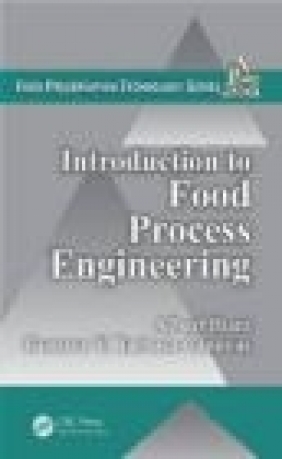Introduction to Food Process Engineering
Gustavo Barbosa-Canovas, Albert Ibarz
Introduction to Food Process Engineering
Gustavo Barbosa-Canovas, Albert Ibarz
- Producent: CRC Press Inc.
- Rok produkcji: 2014
- ISBN: 9781439809181
- Ilość stron: 722
- Oprawa: Twarda
Niedostępna
Opis: Introduction to Food Process Engineering - Gustavo Barbosa-Canovas, Albert Ibarz
Consumer expectations are systematically growing, with demands for foods with a number of attributes, which are sometimes difficult for manufacturers to meet. The engineering processes that are needed to obtain top-quality foods are a major challenge due to the diversity of raw materials, intermediates, and final products. As in any other enterprise, the food industry must optimize each of the steps in the production chain to attain the best possible results. There is no question that a very important aspect to take into consideration when developing a process, designing a food factory, or modifying existing facilities is the in-depth knowledge of the basic engineering aspects involved in a given project. Introduction to Food Process Engineering covers the fundamental principles necessary to study, understand, and analyze most unit operations in the food engineering domain. It was conceived with two clear objectives in mind: 1) to present all of the subjects in a systematic, coherent, and sequential fashion in order to provide an excellent knowledge base for a number of conventional and unconventional processes encountered in food industry processing lines, as well as novel processes at the research and development stages; 2) to be the best grounding possible for another CRC Press publication, Unit Operations in Food Engineering, Second Edition, by the same authors. These two books can be consulted independently, but at the same time, there is a significant and welcomed match between the two in terms of terminology, definitions, units, symbols, and nomenclature. Highlights of the book include: Dimensional analysis and similarities Physicochemistry of food systems Heat and mass transfer in food Food rheology Physical properties Water activity Thermal processing Chilling and freezing Evaporation Dehydration Extensive examples, problems, and solutionsIntroduction to Unit Operations Process Food Process Engineering Transformation and Commercialization of Agricultural Products Flowcharts and Description of Some Food Processes Steady and Unsteady States Discontinuous, Continuous, and Semicontinuous Operations Unit Operations: Classification Mathematical Setup of the Problems Unit Systems, Dimensional Analysis, and Similarities Magnitude and Unit Systems Dimensional Analysis Similarity Theory Problems Introduction to Transport Phenomena Historical Introduction Transport Phenomena Circulation Regimes: Reynolds Experiment Transport Phenomena Mechanisms Momentum, Energy, and Mass Transfer Introduction Momentum Transfer: Newton's Law of Viscosity Energy Transfer: Fourier's Law of Heat Conduction Mass Transfer: Fick's Law of Diffusion General Equation of Velocity Macroscopic Balances Introduction Macroscopic Mass Balance Macroscopic Energy Balance Problems Physicochemistry of Food Systems Introduction General Concepts Zeroth Law of Thermodynamics First Principle of Thermodynamics Enthalpy Heat Capacity Second Principle of Thermodynamics: Entropy Thermal Machines: Carnot's Cycle Third Principle of Thermodynamics Chemical Thermodynamics Helmholtz Free Energy Gibbs Free Energy Chemical Potential: Phase Equilibrium Phase Diagram Mass Transfer Introduction Mass Transfer by Diffusion Mass Transfer by Convection Unsteady Mass Transfer Air-Water Interactions Introduction Properties of Humid Air Mollier's Psychrometric Diagram for Humid Air Wet Bulb Temperature Adiabatic Saturation of Air Problems Proposed Problems Water Activity Introduction Definition of Water Activity Methods to Measure Water Act Prediction of Water Activity in Binary Solutions Prediction of Water Activity in Multicomponent Solutions Sorption Isotherms Problems Mechanical Properties Density Porosity Size and Shape Problems Thermal Properties of Food Thermal Conductivity Specific Heat Thermal Diffusivity Problems Optical Properties of Foods Color Characteristics of Color Color Perception Colorimetry Color Systems Problems Rheology of Food Products Introduction Stress and Deformation Elastic Solids and Newtonian Fluids Viscometric Functions Rheological Classification of Fluid Foods Newtonian Flow Non-Newtonian Flow Viscoelasticity Effect of Temperature Effect of Concentration on Viscosity Mechanical Models Rheological Measures in Semiliquid Foods Problems Proposed Problems Electrical Properties of Foods Introduction Electric Resistance and Conductivity Electric Energy Alternating Current Dielectric Proper Physical and Chemical Properties of Food Powders Introduction Physical Properties Chemical and Physicochemical Properties Application of Compression in Foods Research Update in Food Powder Properties Heat Transfer by Conduction Fundamental Equations in Heat Conduction Heat Conduction under Steady Regime Heat Conduction under Unsteady State Problems Proposed Problems Heat Transfer by Convection Introduction Heat-Transfer Coefficients Concentric Tube-Heat Exchangers Shell and Tube-Heat Exchangers Plate-Type Heat Exchangers Extended Surface Heat Exchangers Scraped-Surface Heat Exchangers Agitated Vessels with Jacket and Coils Heat Exchange Efficiency Problems Proposed Problems Heat Transfer by Radiation Introduction Fundamental Laws Physical Properties Associated with Radiation View Factors Exchange of Radiant Energy between Surfaces Separated by Nonabsorbing Media Radiation Heat Transfer Coefficient Simultaneous Heat Transfer by Convection and Radiation Problems Proposed Problems Refrigeration Introduction Refrigerants Refrigeration Mechanical Systems Multipressure Systems Gas Refrigeration Cycles Food Chilling Freezing Thermal Properties of Frozen Foods Freezing Time Design of Freezing Systems Problems Proposed Problems Thermal Processing of Foods Introduction Thermal Death Rate Treatment of Canned Products Thermal Treatment in Aseptic Processing Problems Proposed Problems Emerging Technologies in Food Processing Introduction Ionizing Irradiation Microwave and RF Heating Infrared Heating Ohmic Heating High-Pressure Treatment High-Intensity Pulsed Electric Fields Treatment Problems Concentration Evaporation Heat Transfer in Evaporators Single Effect Evaporators Use of Released Vapor Multiple Effect Evaporators Evaporation Equipment Freeze Concentration Freezing Temperature Ice Crystal Formation Mechanisms Freeze Concentration Equipment Evaluation of Freeze Concentration Process Effectiveness Problems Dehydration Introduction Mixing of Two Air Streams Mass and Heat Balances in Ideal Dryers Dehydration Mechanisms Chamber and Bed Dryers Dehydration Introduction Mixing of Two Air Streams Mass and Heat Balances in Ideal Dryers Dehydration Mechanisms Chamber and Bed Dryers Freeze-Drying Other Types of Drying Problems Hygienic Design of Food Processes Introduction Disinfection and Cleaning Kinetics Disinfection and Cleaning Products Disinfection and Cleaning Processes Packaging of Foods Introduction Packaging Materials Packaging Material Choice Food Packaging and Modified Atmosphere Mass Transfer through Packaging Materials Appendix References Index
Szczegóły: Introduction to Food Process Engineering - Gustavo Barbosa-Canovas, Albert Ibarz
Tytuł: Introduction to Food Process Engineering
Autor: Gustavo Barbosa-Canovas, Albert Ibarz
Producent: CRC Press Inc.
ISBN: 9781439809181
Rok produkcji: 2014
Ilość stron: 722
Oprawa: Twarda
Waga: 1.36 kg



















